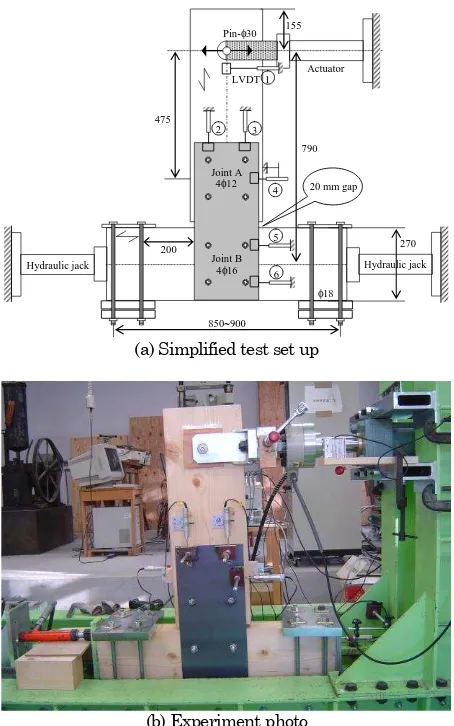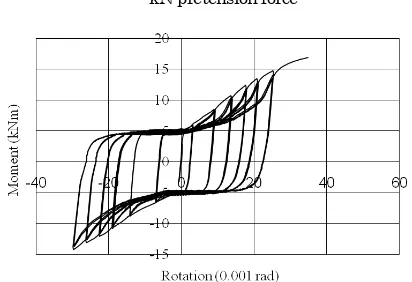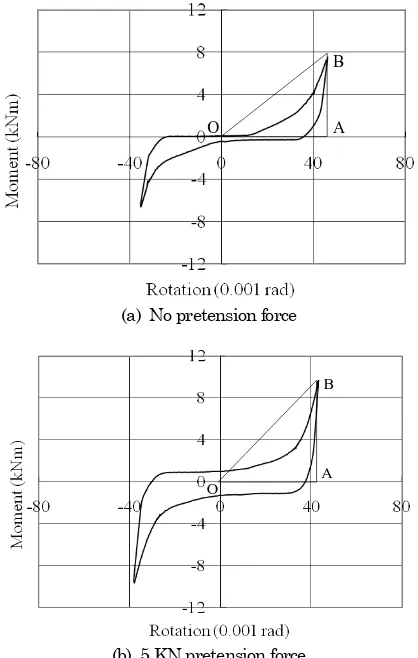Beam to Column Timber Joints with Pretensioned Bolts
Awaludin, A.1, Hirai, T.2, Sasaki, Y.2, Hayashikawa, T.3, and Oikawa, A.3
Abstract: The effects of pretension in bolts on hysteretic response of timber joints exposed to a
bending had been reported by the authors, but the cyclic tests were carried out at small displacement level which might not be applicable for earthquake-resistance design. In this study, similar cyclic tests but at large displacement levels were conducted. Beam to column timber joints with steel side plates were fabricated and continuously loaded until failure. At connection, the bolts were pretension in four different magnitudes: 0 kN, 5 kN, 10 kN and 15 kN. The results showed that frictional action between the steel side plates and wood member as a result of bolt pretensioning significantly increased the (frictional) hysteretic damping and the equivalent viscous damping ratio. It is obvious from the test results that the pretension force in bolts has no influence on the maximum joint resistance but decreases the joint rotational deformation.
Keywords: Beam to column joint, cyclic load, hysteretic damping, pretensioned bolt, timber joint.
Introduction
Bolts are utilized extensively in timber connections. The bolts penetrate the members and transfer the load between members by a combination of wood bearing and fastener bending. Pre-drilled hole is often made in the members with a clearance to account for misalignment or moisture-related changes. This lead-hole clearance results in low joint stiffness at initial loading stage. Under cyclic loads, load-displacement curve of bolted joints is typically pinched, which means that they have very little resistance around the zero displacement points [1, 2]. Degradation of joint resistance or stiffness observed during cyclic tests reflects the developing of gaps or cavities between the bolts and the wood around them. Loaded at the same displacement level, strength degradation after three or more cycles has been found to be relatively small. Pouring epoxy resin into the voids between the over-sized hole and bolts was found to improve the joint performance since the bolts experienced little bending defor-mation and fatigue stress [3].
1Department of Civil and Environmental Engineering, Gadjah
Mada University, Grafika 2, UGM campus, Yogyakarta 55281, INDONESIA.
E-mail: ali@tsipil.ugm.ac.id; ali.awaludin@ugm.ac.id
2Research Faculty of Agriculture, Hokkaido University, Kita 9
Nishi 9, Kita-ku, Sapporo 060-8589, JAPAN.
3Research Faculty of Engineering, Hokkaido University, Kita 13
Nishi 8, Kita-ku, Sapporo 060-8628, JAPAN.
Note: Discussion is expected before November, 1st 2011, and will be
published in the “Civil Engineering Dimension” volume 14, number
1, March 2012.
Received 21 May 2010; revised 25 March 2011; accepted 18 April 2011.
An improved joint performance, both strength and ductility ratio, was also reported by gluing high-embedding strength materials at joint shear plane, the interface between two adjacent members [4-7]. The main reason for this local reinforcement is to prevent timber splitting, which in most cases leads to failure of the connection. Some of these reinforcing materials are plywood, plybamboo, steel plate and Densified Veneer Wood (DVW). Recently, viscoelastic (VE) polymer, which is a rubber-like material, was introduced at the shear plane between gypsum sheathing to timber frame connections. Under quasi-static cyclic loads a significant increase of energy dissipation capacity of the connection was reported [8]. The VE polymer dissipates energy via sharing action across the cross section while also adding stiffness to the connection system. Improvement of seismic performance of moment-resisting bolted joints by inserting nails closer to the joint centroid than the bolts was also reported [9].
examined at some higher rotation levels. The objective of this study was to investigate the effect of pretension in bolts on cyclic properties of beam to column timber joints with steel side plates under large displacement levels.
Materials and Methods
Spruce-pine-fir laminate was fabricated by bonding three laminas with resorcinol-formaldehyde resin adhesive. The average moisture content was found to be 13%, while the oven dry specific gravity was 0.38. A beam to column joint model shown in Figure 1 is composed of two glued laminated lumbers (cross section, 100 by 270 mm) that were connected to each other by steel side plates of 4 mm thickness. Four 12 mm bolts were used to connect steel side plates and vertical member, while four 16 mm bolts were used to connect the steel plates and horizontal member. Pre-drilled hole, 1 mm larger than the bolt diameter, was drilled on both wood and steel members to accommodate the possible misalignment.
In this test, the lateral load generated by actuator at the top of vertical wood member has a vertical distance of 475 mm from the joint A or 790 mm from the joint B as shown in Figure 1.
Figure 1. Cyclic test of beam to column joint
The applied load was controlled according to lateral displacement of the vertical wood member measured by LVDT 1. Rotational deformation of both joint A and B was evaluated based on the relative slip measurement between wood member and steel side plate (joint A: LVDT 2, 3 and 4; joint B: LVDT 5 and 6). This measurement was simultaneously per-formed as shown in Figure 1.b. Both ends of the displacement levels (measured by LVDT 1) from ten mm to 70 mm with an interval of ten mm as illustrated in Figure 2. At any displacement level, the cyclic load was repeated three times before going to the next level. Assuming that bending deformation of the vertical wood member is small and can be neglected, lateral displacement measured by LVDT 1 obviously is only the result of bending deformation of the steel side plates and both rotational deformation of the joint A and B (see Fig. 1.b). This is generally applicable in timber structures with semi-rigid joints where member deformation is relatively small compared to the deformation of their joints.
Figure 2. Displacement-controlled loading protocol of the experiment
was generated using a displacement-control rate of 3.75 mm/min in both cyclic and monotonic tests.
Results and Discussions
Typical hysteresis loop of connection between steel plates and vertical member having pretension equals to 0 kN is shown in Figure 3.a. Although the pretension in bolts is nil, joint resistance at zero rotation points after some large rotation levels is not equal to zero. This is because of the axial force development in bolts as a result of joint deformation. When the bolt is bent, the resultant length in the initial longitudinal direction of the bolt must become shorter than the initial length. Because the bolt cannot be withdrawn, the decrease in the longi-tudinal length means necessarily the embedment of steel plates into the wood member. Therefore, the bolt must be subjected to an axial force. The axial force development in bolt as a result of joint
deformation has been associated with “cable” or “rope” effect by many previous studies and it is
substantially affected by slenderness ratio of the bolts.
Hysteresis loop of connection between steel side plates and horizontal member is presented in Figure 3.b where it is clearly seen that pretension in bolts increases the joint resistance at zero rotation points.
(a) Joint between steel plate and vertical member with 0 kN pretension force
(b) Joint between steel plate and horizontal member with 20 kN pretension force
Figure 3. Experimental hysteresis loops
The loop also shows that the joint resistance at zero rotation points is almost the same or no significant additional resistance even though the joint expe-riences higher rotation levels. This fact supports our previous finding that joints with a large pretension in their bolts fail with a smaller joint rotation thus giving minimum rope effect than the non-pre-tensioned joints [14].
Figure 4 shows the experimental hysteresis loops of connection between steel side plates and vertical member for the four different pretension forces. Very high initial stiffness (or joint resistance) due to bolt pretensioning is shown in Figures 4.b to d. Following this high initial joint resistance, interlayer slip or slip between the steel plates and wood member takes places. Joint resistance at this slip occurrence is often referred to as frictional moment resistance since it is basically related to frictional action between steel side plates and wood member. This frictional moment resistance is proportional to the magnitude of pretension force and is negligible in the non-pretensioned joints.
As shown in Figures 4.b to d, the average frictional moment resistance is about 2.16 kNm, 3.71 kNm, and 5.65 kNm for the joints with 5 kN, 10 kN, and 15 kN of pretensioning force per bolt, respectively. Figure 5 shows the relation between pretension in bolts and frictional force, which was derived based on an assumption that frictional moment resistance can be replaced by a couple of frictional force [10]. A linear relation between the pretension and joint frictional force is well indicated in Figure 5 with a friction coefficient of 0.366. This fairly agrees with the static friction coefficient of the same steel plate and timber species reported in our previous study, which varied from 0.28 to 0.34 [14].
10.68 KNm
(a) No pretension force
2.16 kNm 10.53 kNm
(b) 5 KN pretension force
3.71 kNm 10.35 kNm
(c) 10 KN pretension force
5.65 kNm 10.61 kNm
(d)15 KN pretension force
Figure 4. Experimental hysteresis loops of connection between steel side plates and vertical wood member for four different pretension forces
Figure 5. Relation between pretension in bolts and joint frictional resistance
The reduction of joint rotation in the case of joints with pretension in bolts must be compensated by a higher bending deformation of the steel side plates since in all specimens rotational deformation of the connection between steel side plates and horizontal wood member are apparently the same, no different treatment has been applied to this connection. In structural modeling, therefore, bending stiffness of the steel side plates should be taken into consi-deration to produce a more realistic deformed geometry of beam to column joints.
Cyclic rotation of (around) 0.04 rads was arbitrarily chosen to examine the influence of pretension force on hysteretic damping of the joints. The final (or stabilized) hysteresis loop at cyclic rotation of 0.04 rads is separated from the complete curve and shown in Figure 6 for both non-pretensioned and pretensioned joints. In the case of non-pretensioned joints (Fig. 6.a), the rotation of 0.04 rads is about 50% of the joint rotation that corresponds to the maximum resistance. While in the case of pretensioned joints (Fig. 6.b), this rotation level is approximately the same as the joint rotation that corresponds to the maximum resistance. The equivalent viscous damping ratio of the joints was evaluated as
P D eq
E E
4 1
(1)
where potential energy (EP) is the area of the triangle AOB and hysteretic damping (ED) is the area enclosed by the moment rotation loop (Fig. 6.a).
A B
O
(a) No pretension force
A B
O
(b) 5 KN pretension force
Figure 6. The final hysteresis loop at 0.04 rads
Table 1. Equivalent viscous damping ratio (
eq) at cyclic rotation of 0.04 radsPretension in bolt 0 kN 5 kN 10 kN 15 kN
eq
0.06 0.09 0.13 0.22Conclusions
Cyclic tests at large displacement levels followed by monotonic tests were carried out on beam to column timber joints to examine the influence of pretensioning in bolts on their cyclic properties. In this study, four different pretension forces: 0 kN, 5 kN, 10 kN and 15 kN per bolt were considered. Besides increase of initial joint slip resistance, introducing pretension force in bolt leads to a significant increase of hysteretic damping or the area enclosed by the loop and equivalent viscous damping ratio. Hysteretic damping of a pretensioned joint was substantially enlarged by frictional action between the steel side plates and wood member as a result of bolt pretensioning. The test results informed that pretension in bolts has no influence on the maximum joint resistance but substantially decreases the joint rotation.
Acknowledgement
This study was carried out when the first author (A.A.) was a post-doctoral research fellow in the Laboratory of Bridge and Structural Design Engi-neering, Hokkaido University, Sapporo, under the Japan Society for the Promotion of Science post-doctoral fellowship program. A continuous support from the Japan Society for the Promotion of Science from 2008 to 2010 is sincerely acknowledged.
References
1. Prion, H. and Foschi, R., Cyclic Behaviour of Dowel Type Connections, Proceedings of the Pacific Timber Engineering Conference, Gold Coast, Australia, Vol. 2, July 11-15, 1994, pp. 19-25.
2. Foliente, G.C., Hysteresis Modeling of Wood Joints and Structural Systems, Journal of Structural Engineering, ASCE, Vol. 121, 1995, pp. 1013-1022.
3. Watanabe, H. and Iimura, Y., Ultimate Behavior of Bolt Joints for Glulam Bridges under Cyclic Load, Proceedings of the 9th World Conference on Timber Engineering, Portland, August 6-10, 2006. (CD-ROM)
4. Awaludin, A., Sasaki, Y., Oikawa, A., Hirai, T., and Hayashikawa, T., Moment Resisting Timber Joints with High-Strength Steel Dowels: Natural Fiber Reinforcements, Proceedings of the 11th World Conference on Timber Engineering, Tren-tino, June 20-24, 2010. (CD-ROM)
5. Blass, H.J., Schmid, M., Litze, H., and Wagner, B., Nail Plate Reinforced Joints with Dowel-Type Fasteners, Proceedings of the 6th World Confe-rence on Timber Engineering, Whistler, July 31– August 3, 2000. (CD-ROM)
6. Leijten, A.J.M., Ruxton, S., Prion, H., and Lam, F., Reversed-Cyclic Behavior of a Novel Heavy Timber Tube Connection, Journal of Structural Engineering, ASCE, Vol. 132, 2006, pp. 1314-1319.
7. Guan, Z.W. and Rodd, P.D., A Three-Dimensional Finite Element Model for Locally Reinforced Timber Joints Made with Hollow Dowel Fas-teners, Canadian Journal of Civil Engineering, Vol. 27, 2000, pp. 785-797.
9. Awaludin, A., Hayashikawa, T., Oikawa, A., Hirai, T., Sasaki, Y., and Leijten, A.J.M, Seismic Properties of Moment-Resisting Timber Joints with a Combination of Bolts and Nails, Civil Engineering Dimension, Vol. 13(1), 2011, pp. 1-5.
10. Awaludin, A., Hirai, T., Hayashikawa, T., Sasaki, Y. and Oikawa, A., Effects of Pretension in Bolts on Hysteretic Response of Moment-Carrying Timber Joints, Journal of Wood Science, Vol. 54(2), 2008, pp. 114-120.
11. Architecture Institute of Japan: Standard for Structural Design of Timber Structures, Archi-tecture Institute of Japan, Tokyo, 2006, pp. 13-14 and 400.
12. Manrique, R.E., Stress Relaxation of Wood at Several Levels of Strain, Journal of Wood Science and Technology, Vol. 3, 1969, pp. 49-73.
13. Awaludin, A., Hirai, T., Hayashikawa, T., Sasaki, Y., and Oikawa, A., One-Year Stress Relaxation of Timber Joints Assembled with Pretensioned Bolts, Journal of Wood Science, Vol. 54(6), 2008, pp. 456-463.



